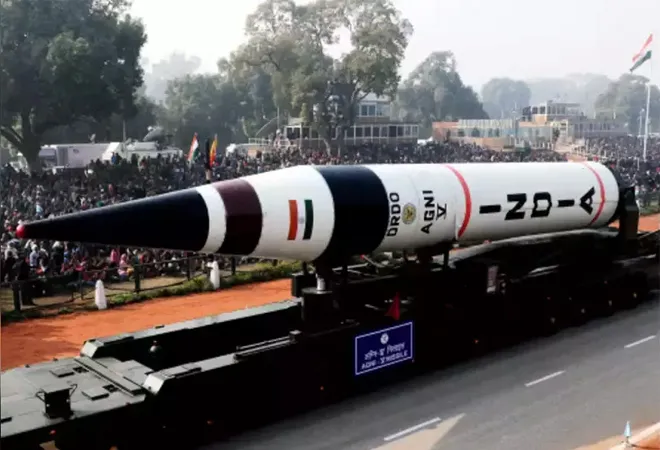 This piece is part of the series, 25 Years Since Pokhran II: Reviewing India’s Nuclear Odyssey
This piece is part of the series, 25 Years Since Pokhran II: Reviewing India’s Nuclear Odyssey
The 25
th anniversary of India’s nuclear tests at Pokhran is an opportunity to reflect on the country’s nuclear weapon capabilities. India’s nuclear triad has been bolstered in recent years by
advancements in delivery vehicles. More than a decade after Indian scientists began working on the Agni-V, the missile has matured through a process of iteration and testing. On 15 December 2022, the Defence Research and Development Organisation (DRDO) conducted the ninth
test-firing of the nuclear-capable ballistic missile. DRDO officials claim that the missile’s range of 5,000 km puts it in the category of an intermediate-range ballistic missile (IRBM) rather than an ICBM. But Agni-V’s actual range is said to exceed 5,500 km, the minimum range for an ICBM. That gives it the vital capability to strike targets in China.
The test-firing of a nuclear-capable submarine-launched ballistic missile (SLBM) from the Arihant in October 2022 has added to the optimism surrounding Indian deterrence capability.
Also significant from a strategic standpoint is the
launch of the S-4 in November 2022, India’s third indigenous nuclear ballistic missile submarine (SSBN). Four years after the INS Arihant, India’s first indigenous SSBN, became
fully operational, the Indian Navy is said to have quietly launched the S-4 at a facility in Visakhapatnam. The submarine is reportedly bigger than the INS Arihant and Arighat, with more space for nuclear-tipped ballistic missiles. Compared to its predecessor platforms’ four vertical-launch missile tubes, the S-4 has at least eight tubes for nuclear missiles. The
test-firing of a nuclear-capable submarine-launched ballistic missile (SLBM) from the Arihant in October 2022 has added to the optimism surrounding Indian deterrence capability. Many see the test as a step towards assured retaliation. A submarine in the depths of the ocean, they rightly suggest, is best suited to respond to a nuclear provocation by an adversary.
Undersea dilemmas
Nonetheless, the sea component of the triad is facing trials of its own. The commissioning of the INS Arighat, the second SSBN, currently undergoing sea trials, has ostensibly been delayed. Launched in 2017, the submarine was scheduled to be commissioned in 2021, but it will likely be
inducted only in 2024. An SSBN must undergo extensive machinery and systems checks and an exhaustive procedure of command, control, and communications verification before commissioning. The process can often be cumbersome, but rarely does it cause the kind of delays being witnessed with the Arighat. A related worry is the lack of progress in testing and operationalising longer-range SLBMs. Recent missile
tests from the Arihant have been of the K-15 (700 km); the longer-range K-4 (3500 km) isn’t being tested enough in operational conditions, though it is the only SLBM with the range to make deterrence against China credible.
A nuclear submarine usually has a system of negative control with de-mated missile systems and electronic locks (permissive action links) attached to the weapon system.
There are also
issues of nuclear command, control, and communication. Operational planners and Strategic Forces Command officials are still coming to grips with implementing weapon controls on SSBNs and addressing the problems of deep-sea communications. A nuclear submarine usually has a system of negative control with de-mated missile systems and electronic locks (permissive action links) attached to the weapon system. The locks preclude arming and launching of the missiles without the insertion of a prescribed electronic discrete code by the command authority. With cannisterised missiles on the Arihant, the warheads are supposedly pre-mated. It is for the submarine captain to launch a missile on explicit orders from the command authority. But communication with an SSBN is tricky because the very low-frequency systems in use on the submarine are
prone to disruption at great depths.
The air component
The air leg of the triad seems relatively robust. The induction of the Rafale aircraft has provided the Indian Air Force with a sophisticated aircraft with nuclear-warhead-carrying capability. The aircraft is widely seen as the
chosen fighter to deliver nuclear weapons, more so than the older Anglo-French Jaguar and the Russian-made Sukhoi Su-30. It is reassuring for some that the air (and land) elements of the triad have civilian scientists maintaining, preparing, and connecting the nuclear warhead. It generates confidence that command and control will be properly exercised. Unlike cannisterised missiles with pre-mated warheads on SSBNs, air- and land-based missile warheads are physically removed from their delivery vehicles.
A complicated dynamic in South Asia
The deterrence discussion has a broader context. Indian nuclear capabilities, while outwardly credible, ought not to be assessed in isolation; they should be weighed against the capabilities of China and Pakistan. Both countries have sophisticated arsenals and believe they have the assets to credibly deter India. What complicates matters, however, is Beijing and Islamabad’s perception of strategic stability in South Asia, in particular the latter’s suspicion that Indian attempts to develop ballistic missile defence (BMD) are intended to generate strategic asymmetry with Pakistan.
The aircraft is widely seen as the chosen fighter to deliver nuclear weapons, more so than the older Anglo-French Jaguar and the Russian-made Sukhoi Su-30.
Indian observers tend to see BMD as a benign defensive shield. The regular flight trials of interceptor missiles (one endo-atmospheric interceptor missile
test was recently held in the Bay of Bengal), are seen as naturally complementing India’s “No first use” (NFU) nuclear policy that emphasises defensive capability as a way of strengthening deterrence. Pakistan, however, sees it differently. Islamabad believes that India’s attempts to develop BMD capability are meant to reduce the effectiveness of Pakistan’s nuclear arsenal. Islamabad has
sought "cost-effective solutions" in the shape of MIRV (multiple independently targetable re-entry vehicles) and cruise missiles, a form of deterrence Pakistani officials describe as “full spectrum,” involving the employment of an array of strategic, tactical, and operational weapons. This underlines an essential dilemma for India: Its nuclear doctrine does not really account for the use of tactical nuclear weapons by Pakistan.
As some Indian
experts see it, New Delhi’s stance on nuclear weapons—that these are ‘political’ rather than battlefield weapons, meant only to deter nuclear power adversaries —is gravely outdated. The critics point to the blurring of the line between conventional and nuclear deterrence. The three core tenets of India’s nuclear doctrine—credible minimum deterrence, massive retaliation, and NFU—are, they aver, from a bygone era and no longer fit for purpose. If anything, the NFU and New Delhi’s continuing emphasis on “minimum” limit the size of the arsenal to levels well below the level needed for credible deterrence. Furthermore, India’s reluctance to revisit the nuclear doctrine and its refusal to accelerate the nuclear weapons programme—despite clear evidence of the growing arsenals of Pakistan and China—hurts the cause of strategic stability. Sceptics say India’s insistence on keeping a small arsenal and yet “retaliating massively” to a nuclear attack is irreconcilable with the idea of credible minimum deterrence.
Islamabad believes that India’s attempts to develop BMD capability are meant to reduce the effectiveness of Pakistan’s nuclear arsenal.
For
other observers, tinkering with the nuclear doctrine is unnecessary, even counterproductive. The issue, NFU proponents aver, is not that India’s nuclear doctrine is unviable; rather, dropping NFU will impose a burden on India in terms of investment in financial and technological capabilities to make a ‘first use’ credible. If New Delhi is certain about never having to carry out a first disarming or decapitating strike on its adversaries, there is no reason for it to be sucked into an arms race by switching over to a first-use doctrine. The 160 warheads and new delivery vehicles that India possesses are enough to convey resolve to opponents; deterrence is credible, even if only just.
Abhijit Singh is a Senior Fellow and heads the Maritime Policy Initiative at the Observer Research Foundation
The views expressed above belong to the author(s). ORF research and analyses now available on Telegram! Click here to access our curated content — blogs, longforms and interviews.



 This piece is part of the series,
This piece is part of the series,  PREV
PREV


